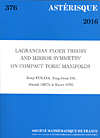- About MAA
- Membership
- MAA Publications
- Periodicals
- Blogs
- MAA Book Series
- MAA Press (an imprint of the AMS)
- MAA Notes
- MAA Reviews
- Mathematical Communication
- Information for Libraries
- Author Resources
- Advertise with MAA
- Meetings
- Competitions
- Programs
- Communities
- MAA Sections
- SIGMAA
- MAA Connect
- Students
- MAA Awards
- Awards Booklets
- Writing Awards
- Teaching Awards
- Service Awards
- Research Awards
- Lecture Awards
- Putnam Competition Individual and Team Winners
- D. E. Shaw Group AMC 8 Awards & Certificates
- Maryam Mirzakhani AMC 10 A Awards & Certificates
- Two Sigma AMC 10 B Awards & Certificates
- Jane Street AMC 12 A Awards & Certificates
- Akamai AMC 12 B Awards & Certificates
- High School Teachers
- News
You are here
Lagrangian Floer Theory and Mirror Symmetry on Compact Toric Manifolds

Publisher:
Société Mathématique de France
Publication Date:
2016
Number of Pages:
340
Format:
Paperback
Series:
Astérisque 376
Price:
82.00
ISBN:
9782856298251
Category:
Monograph
[Reviewed by , on ]
Michael Berg
05/5/2016
This is a highly specialized research monograph, of considerable length (over 300 pages), dealing with an interacting pair of deep and beautiful themes: one theme is still quite young, while the other is somewhat older, at least as far as mathematical chronological reckoning goes. The context for this work is the former theme, mirror symmetry, which entails something of a network of matchings, or correspondences, between invariants of, on the one hand, smooth manifolds equipped with integrable complex structures, and, on the other hand, these same manifolds equipped with symplectic structures (see the on-line lectures by Nicholas Sheridan were given at IAS in 2013). The invariants are fitted into schemes of so-called open or closed A- or B- models (all four possibilities get to play: we meet string theory here, up close and personal, in mathematical garb), and involve, for example, Gromov-Witten invariants and Fukaya categories. In short (and very inadequately), this is avant garde stuff by any measure, dealing with a recently discovered place in mathematics where algebraic and differential geometry meet nothing less than the physics of string theory, and so we find ourselves face to face with some of the sportiest hypermodern developments coming on the heels of certain very sexy developments in theoretical physics, as well as differential and symplectic geometry — this is the place, for example, where Maxim Kontsevich made such dramatic discoveries not long ago.
The other major player in the game is Floer homology, which was developed by Andeas Floer to attack the Arnol’d conjecture and is situated in the area of Morse theory, broadly interpreted. Indeed, the history of the latter subject is fascinating in its own right and illustrates something that is currently central to differential geometry (again, broadly interpreted: things are evolving fast), namely, the synergy between mathematics and physics that is associated with such scholars as Sir Michael Atiyah, Graeme Segal, Raoul Bott, and of course Edward Witten. The impetus for this rapprochement might be identified as Witten’s reworking of Morse theory in his famous paper “Supersymmetry and Morse Theory” in the wake of Stephen Smale’s interpretation of Morse theory in terms of dynamical systems. The interested reader should take a look at Bott’s “Morse Theory Indomitable”, an utterly irresistible article. This is the background for Floer’s stunning work which went on to pay such huge dividends.
That having been said, the article under review’s explicit goal is “to prove a version of mirror symmetry between [a] compact toric A-model and [a] Landau-Ginzburg B-model.” The role played by Floer homology is described as follows: “Hochschild and cyclic (co)homology of Lagrangian Floer cohomology and of [the] Fukaya category is [sic] known to be related to the quantum cohomology of the ambient symplectic manifold. We prove and use this relationship in this paper.” Obviously this effects a reiteration of what was alluded to above, namely, that we are dealing with highly specialized research and that, therefore, the interested reader, unless already so equipped, should be prepared to do a lot of preliminary work before diving into this volume of Astérisque. In fact, there may be something of a contrapositively twisted “Catch 22” in effect here: in order to be properly interested in this business, the reader needs to know a lot about it already!
Michael Berg is Professor of Mathematics at Loyola Marymount University in Los Angeles, CA.
See the table of contents in pdf format.
- Log in to post comments




